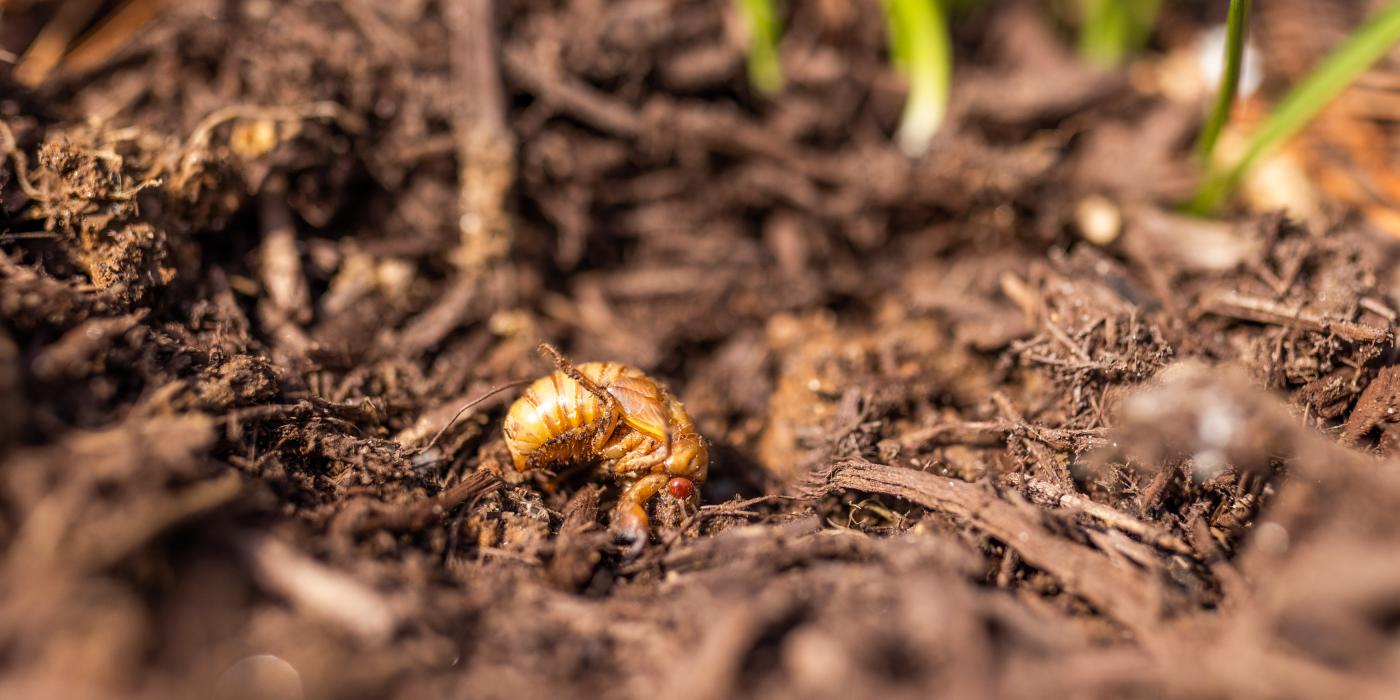Cicada Snacks: The Wild (and Tasty) Side of Brood X at the Zoo
They slumber underground for 16 summers, nestled near tree roots, sipping xylem — the nutrient-poor water inside tree tissues. Then, as ground temperatures rise on the 17th summer, they emerge and begin blindly burrowing their way toward the surface, bursting forth to a summer of song, flight and love.
It sounds like a spooky fairytale but in fact, it’s the actual true story of the 17-year Brood X cicadas and for some Zoo animals, the beginning of a tasty bug buffet.
Washington, D.C., Maryland and Virginia have cicadas every summer. Their song is the soundtrack to the region’s warmest days and sultriest nights. We rarely see those cicadas, though, because while they do sing, they are also camouflaged to blend into the trees. Their survival strategy is to hide to avoid being eaten.
Brood X cicadas take a different track. With flashy Tonka-truck colored wings and vivid scarlet eyes, they’re nothing if not showy. Their strategy, rather than hiding, is to exist in such vast numbers that enough survive to mate and lay eggs in new young tree stems. The larvae then hatch and fall to the ground looking for grass or any other plants that offer a place to hide before burrowing down to tree roots, ensuring the next Brood X generation emerges 16 years from now.
Magic Cicadas
Three species of cicadas make up Brood X 17-year cicadas, all in the genus Magicicada. The genus name actually means “many”— a reference to their overwhelming numbers — but for entomologist and Amazonia exhibit keeper Donna Stockton at the Smithsonian’s National Zoo and Conservation Biology Institute, it might as well mean what it sounds like: magical.
“I could talk about cicadas all day,” Stockton enthuses. “The 17-year emergence is such an exciting time because it gives people a chance to learn about these amazing insects that otherwise they wouldn’t see, because the cicadas we have every year are camouflaged.”
Their coloring is striking, but what really sets the Brood X cicadas apart, aside from their sheer numbers, are their songs. Specifically, the volume of those songs.
“You think our annual cicadas are loud when you hear their little chirping, wait until you hear the 17-year cicadas,” Stockton said. “Their calls can get really loud — almost like an airplane flying over. Each species has its own call, but they’re all loud.”
People all over the Washington, D.C. region will be able to hear the cicadas, and some lucky, observant ones may also be able to spot the “chimneys” cicadas often build up from the ground. Similar to a crayfish turret, the chimneys are most visible on bare ground without too many leafy trees and can reach heights of up to a foot.
The cicadas crawl out of the ground as the ground temperatures reach 64 or 65 degrees Fahrenheit. They molt a number of times underground, shedding their exoskeletons as they grow larger. By the time they ascend their chimneys and emerge from the soil, they’re brown and crunchy nymphs. They molt one more time before they transform into their final winged stage. Then the males start singing to attract females and mate. The female cicadas lay eggs, and both parents die. Their life cycle is over for another 17 years.
Cicadas at the Zoo
Given that it has been 17 years since their last emergence, zoo keepers and scientists aren’t entirely sure what to expect from Brood X. Though, given the size of the Zoo and the number of trees on it, they’re expecting a fair showing of cicadas.
“There are stories from last time of keepers using shovels and brooms to sweep cicada larvae off Olmsted,” said Mike Maslanka, head of nutrition science, referring to the main pathway through the Zoo named for famous landscape designer Frederick Law Olmsted. “Looking at the map, we do expect more of an impact at the Zoo in Washington, D.C., than out at the Conservation Biology Institute in Front Royal, Virginia.”
When the cicadas emerge from the ground, they are typically as plump, soft and well-fed as they’re going to get, and a number of animals find them irresistible. Maslanka notes that all the bears — sloth bears, Andean bears, and the giant pandas — will likely be interested in the cicadas, along with the maned wolves and otters.
Sloth bears evolved to eat insects. The giant pandas and Andean bears, usually herbivores, are not likely to turn down such tasty plump larvae should they emerge in the panda yard. Maned wolves subsist mainly on small animals and insects, so they are likely to be thrilled by the smorgasbord erupting in their yards. And otters, especially the nimble-pawed Asian small-clawed otters, will delight in digging up and consuming the tasty treats.
The cicadas are safe for the Zoo animals to eat. The only concern Maslanka has is making sure that none of the animals eat too many of them. They know the cicadas are high in protein, but they are insects and, when in their winged form, they can be harder to digest than other, softer, foods. The nutritionists are discussing possibly collecting and freezing some of the larva to study or save for animal enrichment later.
